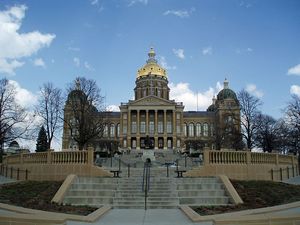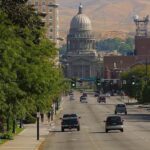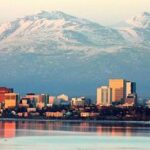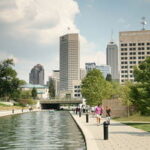This article, the fifteenth in a 50-state series, lists the largest cities in Iowa by population size and provides demographic details for each city: total population, population by age group, racial composition of the population, land area, and population density. For purposes of this article, cities are incorporated municipalities and census-designated places (CDPs).
After reading “Largest Cities in Iowa (2011),” return to this link to read “Best Places to Live in Iowa (2011).”
Similar articles for the remaining 49 states can be found at these links: Alabama, Alaska, Arizona, Arkansas, California, Colorado, Connecticut, Delaware, Florida, Georgia, Hawaii, Idaho, Illinois, Indiana, Kansas, Kentucky, Louisiana, Maine, Maryland, Massachusetts, Michigan, Minnesota, Missouri, Mississippi, Montana, Nebraska, Nevada, New Hampshire, New Jersey, New Mexico, New York, North Carolina, North Dakota, Ohio, Oklahoma, Oregon, Pennsylvania, Rhode Island, South Carolina, South Dakota, Tennessee, Texas, Utah, Vermont, Virginia, Washington, West Virginia, Wisconsin, and Wyoming.
1. Largest Cities in Iowa (2011): Des Moines, IA
Located in central Iowa, Des Moines is the state’s capital and largest city with an estimated population of 203,433.
Grouped by age, 24.8% of the population is under 18, 10.8% is 18 to 24, 29.4% is 25 to 44, 23.9% is 45 to 64, and 11.1% is 65 or older. The median age of the population is 33.5.
The racial composition of the city is 76.4% White, 10.2% Black or African American, 0.5% Native American, 4.4% Asian, 0.1% Pacific Islander, 5.0% from other races, and 3.4% from two or more races. The population is 12.0% Hispanic or Latino of any race.
The land area of the city is 75.8 square miles. The city’s population density is 2,684 people per square mile.
2. Largest Cities in Iowa (2011): Cedar Rapids, IA
Situated in eastern Iowa, Cedar Rapids is the second largest city in the state with an estimated population of 126,326.
Classified by age, 23.5% of the population is under 18, 11.3% is 18 to 24, 27.5% is 25 to 44, 24.7% is 45 to 64, and 13.0% is 65 or older. The median age of the population is 35.3.
The racial complexion of the city is 88.0% White, 5.6% Black or African American, 0.3% Native American, 2.2% Asian, 0.1% Pacific Islander, 0.9% from other races, and 2.9% from two or more races. The population is 3.3% Hispanic or Latino of any race.
The land area of the city is 63.1 square miles. The city’s population density is 2,002 people per square mile.
3. Largest Cities in Iowa (2011): Davenport, IA
Located in eastern Iowa, Davenport is the third largest city in the state with an estimated population of 99,685.
Categorized by age, 24.0% of the population is under 18, 10.7% is 18 to 24, 27.2% is 25 to 44, 25.5% is 45 to 64, and 12.6% is 65 or older. The median age of the population is 35.3.
The racial profile of the city is 80.7% White, 10.8% Black or African American, 0.4% Native American, 2.2% Asian, 2.1% from other races, and 3.9% from two or more races. The population is 7.3% Hispanic or Latino of any race.
The land area of the city is 62.8 square miles. The city’s population density is 1,587 people per square mile.
4. Largest Cities in Iowa (2011): Sioux City, IA
Situated in western Iowa, Sioux City is the fourth largest city in the state with an estimated population of 82,684.
Sorted by age, 26.6% of the population is under 18, 11.4% is 18 to 24, 25.6% is 25 to 44, 24.0% is 45 to 64, and 12.4% is 65 or older. The median age of the population is 33.7.
The racial makeup of the city is 80.6% White, 2.9% Black or African American, 2.6% Native American, 2.7% Asian, 0.1% Pacific Islander, 7.4% from other races, and 3.7% from two or more races. The population is 16.4% Hispanic or Latino of any race.
The land area of the city is 54.8 square miles. The city’s population density is 1,509 people per square mile.
5. Largest Cities in Iowa (2011): Waterloo, IA
Located in the northeastern part of central Iowa, Waterloo is the fifth largest city in the state with an estimated population of 68,406.
Categorized by age, 23.7% of the population is under 18, 10.5% is 18 to 24, 26.4% is 25 to 44, 25.5% is 45 to 64, and 13.9% is 65 or older. The median age of the population is 35.9.
The racial profile of the city is 77.3% White, 15.5% Black or African American, 0.3% Native American, 1.1% Asian, 0.3% Pacific Islander, 2.6% from other races, and 3.0% from two or more races. The population is 5.6% Hispanic or Latino of any race.
The land area of the city is 60.7 square miles. The city’s population density is 1,571.35 people per square mile.
6. Largest Cities in Iowa (2011): Iowa City, IA
Situated in eastern Iowa, Iowa City is the sixth largest city in the state with an estimated population of 67,862.
A large part of the population is college-aged: the city is home to the University of Iowa. Arranged by age, 14.9% of the population is under 18, 33.4% is 18 to 24, 25.7% is 25 to 44, 17.8% is 45 to 64, and 8.2% is 65 or older. The median age of the population is 25.6.
The racial mix of the city is 82.5% White, 5.8% Black or African American, 0.2% Native American, 6.9% Asian, 2.1% from other races, and 2.5% from two or more races. The population is 5.3% Hispanic or Latino of any race.
The land area of the city is 24.2 square miles. The city’s population density is 2,804 people per square mile.
7. Largest Cities in Iowa (2011): Council Bluffs, IA
Situated in southwestern Iowa, Council Bluffs is the seventh largest city in the state with an estimated population of 62,230.
Classified by age, 24.1% of the population is under 18, 10.7% is 18 to 24, 26.1% is 25 to 44, 25.6% is 45 to 64, and 13.5% is 65 or older. The median age of the population is 35.9.
The racial complexion of the city is 90.9% White, 1.9% Black or African American, 0.6% Native American, 0.7% Asian, 3.6% from other races, and 2.4% from two or more races. The population is 8.5% Hispanic or Latino of any race.
The land area of the city is 37.4 square miles. The city’s population density is 1,664 people per square mile.
8. Largest Cities in Iowa (2011): Ames, IA
Located in central Iowa, Ames is the eighth largest city in the state with an estimated population of 58,965.
A significant part of the population is college-aged: the city is home to Iowa State University. Categorized by age, 13.4% of the population is under 18, 40.6% is 18 to 24, 22.9% is 25 to 44, 15.0% is 45 to 64, and 8.1% is 65 or older. The median age of the population is 23.8.
The racial profile of the city is 84.5% White, 3.4% Black or African American, 0.2% Native American, 8.8% Asian, 1.1% from other races, and 2.0% from two or more races. The population is 3.4% Hispanic or Latino of any race.
The land area of the city is 21.6 square miles. The city’s population density is 2,730 people per square mile.
9. Largest Cities in Iowa (2011): Dubuque, IA
Situated in northeastern Iowa, Dubuque is the ninth largest city in the state with an estimated population of 57,637.
Sorted by age, 21.4% of the population is under 18, 12.9% is 18 to 24, 23.3% is 25 to 44, 25.9% is 45 to 64, and 16.5% is 65 or older. The median age of the population is 38.0.
The racial makeup of the city is 91.7% White, 4.0% Black or African American, 0.3% Native American, 1.1% Asian, 0.5% Pacific Islander, 0.6% from other races, and 1.8% from two or more races. The population is 2.4% Hispanic or Latino of any race.
The land area of the city is 26.5 square miles. The city’s population density is 2,175 people per square mile.
10. Largest Cities in Iowa (2011): West Des Moines, IA
Located in central Iowa, West Des Moines is the tenth largest city in the state with an estimated population of 56,609.
Categorized by age, 24.1% of the population is under 18, 9.2% is 18 to 24, 32.6% is 25 to 44, 23.4% is 45 to 64, and 10.7% is 65 or older. The median age of the population is 33.5.
The racial profile of the city is 88.4% White, 3.3% Black or African American, 0.2% Native American, 4.8% Asian, 1.5% from other races, and 1.9% from two or more races. The population is 5.2% Hispanic or Latino of any race.
The land area of the city is 26.8 square miles. The city’s population density is 2,112 people per square mile.
11. Largest Cities in Iowa (2011): Ankeny, IA
Situated in central Iowa, Ankeny is the eleventh largest city in the state with an estimated population of 45,582.
Arranged by age, 27.7% of the population is under 18, 9.3% is 18 to 24, 33.7% is 25 to 44, 21.1% is 45 to 64, and 8.2% is 65 or older. The median age of the population is 31.9.
The racial mix of the city is 94.7% White, 1.2% Black or African American, 0.1% Native American, 2.0% Asian, 0.1% Pacific Islander, 0.6% from other races, and 1.3% from two or more races. The population is 2.3% Hispanic or Latino of any race.
The land area of the city is 29.1 square miles. The city’s population density is 1,566 people per square mile.
12. Largest Cities in Iowa (2011): Urbandale, IA
Situated in central Iowa, Urbandale is the twelfth largest city in the state with an estimated population of 39,463.
Classified by age, 26.1% of the population is under 18, 6.2% is 18 to 24, 28.9% is 25 to 44, 27.0% is 45 to 64, and 11.8% is 65 or older. The median age of the population is 37.8.
The racial complexion of the city is 91.1% White, 2.8% Black or African American, 0.1% Native American, 3.5% Asian, 0.8% from other races, and 1.7% from two or more races. The population is 3.1% Hispanic or Latino of any race.
The land area of the city is 20.7 square miles. The city’s population density is 1,906 people per square mile.
13. Largest Cities in Iowa (2011): Cedar Falls, IA
Located in the northeastern part of central Iowa, Cedar Falls is the thirteenth largest city in the state with an estimated population of 39,260.
Categorized by age, 17.3% of the population is under 18, 29.7% is 18 to 24, 20.5% is 25 to 44, 20.1% is 45 to 64, and 12.4% is 65 or older. The median age of the population is 26.8.
The racial profile of the city is 93.4% White, 2.1% Black or African American, 0.2% Native American, 2.3% Asian, 0.5% from other races, and 1.7% from two or more races. The population is 2.0% Hispanic or Latino of any race.
The land area of the city is 28.3 square miles. The city’s population density is 1,387 people per square mile.
14. Largest Cities in Iowa (2011): Marion, IA
Situated in eastern Iowa, Marion is the fourteenth largest city in the state with an estimated population of 34,768.
Sorted by age, 26.5% of the population is under 18, 7.0% is 18 to 24, 29.3% is 25 to 44, 24.2% is 45 to 64, and 13.0% is 65 or older. The median age of the population is 36.1.
The racial makeup of the city is 93.7% White, 2.0% Black or African American, 0.3% Native American, 1.6% Asian, 0.5% from other races, and 1.9% from two or more races. The population is 2.0% Hispanic or Latino of any race.
The land area of the city is 12.0 square miles. The city’s population density is 2,897 people per square mile.
15. Largest Cities in Iowa (2011): Bettendorf, IA
Located in eastern Iowa, Bettendorf is the fifteenth largest city in the state with an estimated population of 33,217.
Categorized by age, 25.5% of the population is under 18, 6.0% is 18 to 24, 24.6% is 25 to 44, 29.2% is 45 to 64, and 14.7% is 65 or older. The median age of the population is 40.7.
The racial profile of the city is 91.9% White, 2.2% Black or African American, 0.2% Native American, 3.1% Asian, 0.1% Pacific Islander, 0.7% from other races, and 1.8% from two or more races. The population is 3.6% Hispanic or Latino of any race.
The land area of the city is 21.4 square miles. The city’s population density is 1,552 people per square mile.
16. Largest Cities in Iowa (2011): Mason City, IA
Situated in northern Iowa, Mason City is the sixteenth largest city in the state with an estimated population of 28,079.
Arranged by age, 21.9% of the population is under 18, 9.7% is 18 to 24, 23.1% is 25 to 44, 28.2% is 45 to 64, and 17.1% is 65 or older. The median age of the population is 40.9.
The racial mix of the city is 93.8% White, 1.8% Black or African American, 0.3% Native American, 0.9% Asian, 1.3% from other races, and 1.9% from two or more races. The population is 5.1% Hispanic or Latino of any race.
The land area of the city is 25.8 square miles. The city’s population density is 1,088 people per square mile.
17. Largest Cities in Iowa (2011): Marshalltown, IA
Situated in central Iowa, Marshalltown is the seventeenth largest city in the state with an estimated population of 27,552.
Classified by age, 26.1% of the population is under 18, 9.1% is 18 to 24, 23.1% is 25 to 44, 24.9% is 45 to 64, and 16.8% is 65 or older. The median age of the population is 37.3.
The racial complexion of the city is 84.8% White, 2.2% Black or African American, 0.6% Native American, 1.7% Asian, 0.2% Pacific Islander, 7.9% from other races, and 2.6% from two or more races. The population is 24.1% Hispanic or Latino of any race.
The land area of the city is 19.04 square miles. The city’s population density is 1,447 people per square mile.
18. Largest Cities in Iowa (2011): Clinton, IA
Located in eastern Iowa, Clinton is the eighteenth largest city in the state with an estimated population of 26,885.
Categorized by age, 23.1% of the population is under 18, 9.5% is 18 to 24, 22.8% is 25 to 44, 27.6% is 45 to 64, and 17.0% is 65 or older. The median age of the population is 40.4.
The racial profile of the city is 91.0% White, 4.3% Black or African American, 0.4% Native American, 0.7% Asian, 1.1% from other races, and 2.5% from two or more races. The population is 3.3% Hispanic or Latino of any race.
The land area of the city is 35.6 square miles. The city’s population density is 755 people per square mile.
19. Largest Cities in Iowa (2011): Burlington, IA
Situated in southeastern Iowa, Burlington is the nineteenth largest city in the state with an estimated population of 25,663.
Sorted by age, 23.7% of the population is under 18, 7.9% is 18 to 24, 24.6% is 25 to 44, 26.5% is 45 to 64, and 17.3% is 65 or older. The median age of the population is 39.7.
The racial makeup of the city is 88.2% White, 7.2% Black or African American, 0.3% Native American, 0.8% Asian, 0.1% Pacific Islander, 0.7% from other races, and 2.9% from two or more races. The population is 3.1% Hispanic or Latino of any race.
The land area of the city is 14.1 square miles. The city’s population density is 1,820 people per square mile.
20. Largest Cities in Iowa (2011): Fort Dodge, IA
Located in central Iowa, Fort Dodge is the twentieth largest city in the state with an estimated population of 25,206.
Categorized by age, 21.8% of the population is under 18, 13.3% is 18 to 24, 23.4% is 25 to 44, 25.3% is 45 to 64, and 16.2% is 65 or older. The median age of the population is 36.8.
The racial profile of the city is 89.7% White, 5.5% Black or African American, 0.4% Native American, 0.8% Asian, 1.4% from other races, and 2.2% from two or more races. The population is 5.0% Hispanic or Latino of any race.
The land area of the city is 14.6 square miles. The city’s population density is 1,726 people per square mile.
Source(s):
“American Fact Finder,” U.S. Census Bureau
“Population, Housing Units, Area, and Density: 2000,” U.S. Census Bureau







